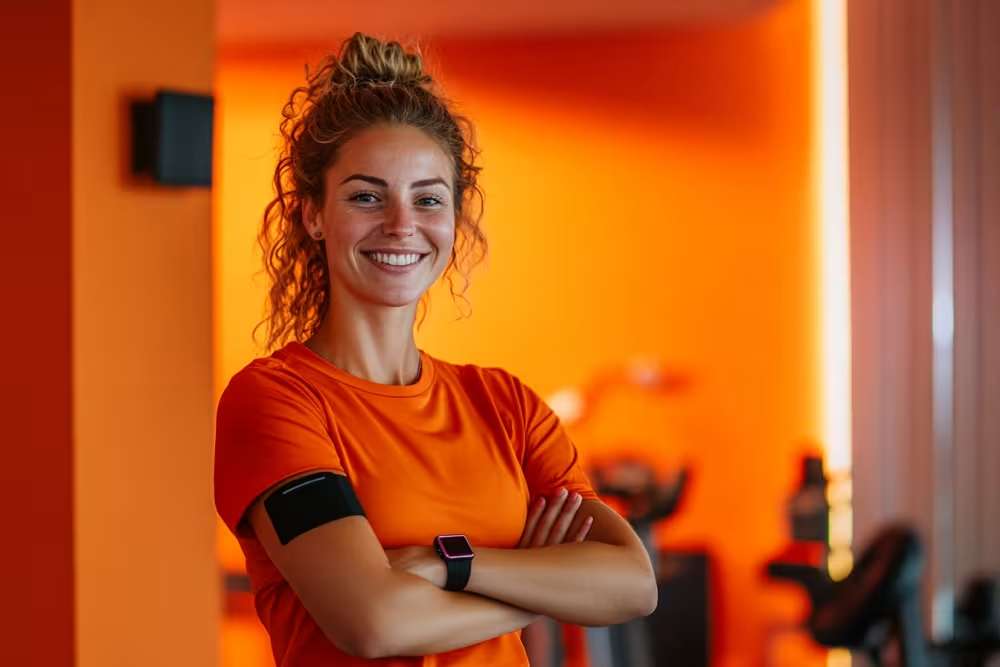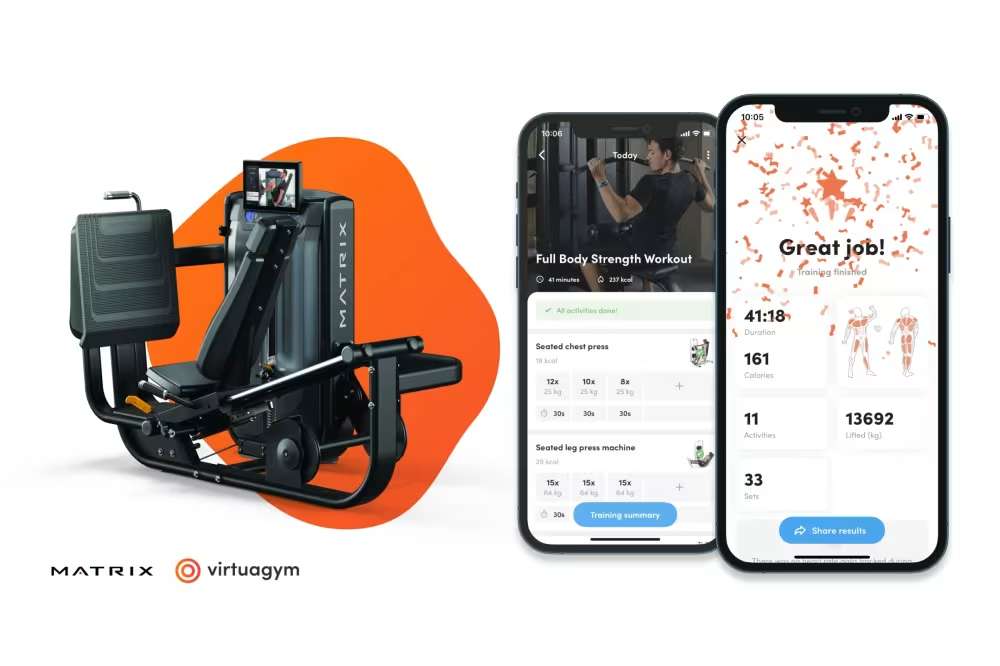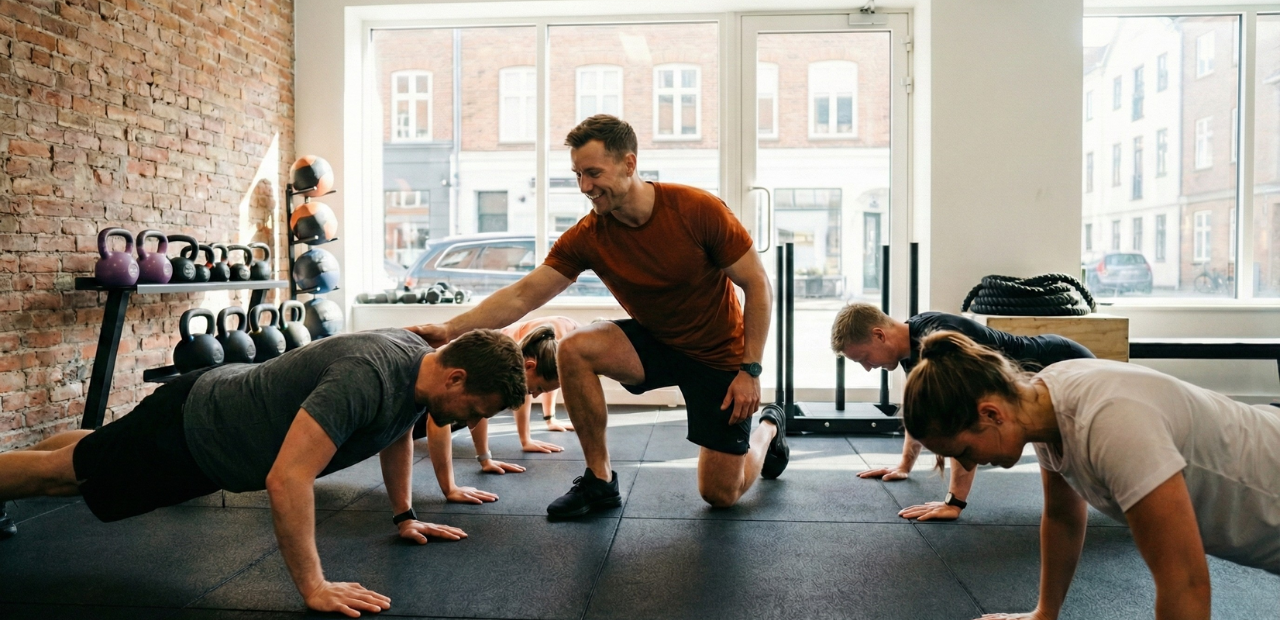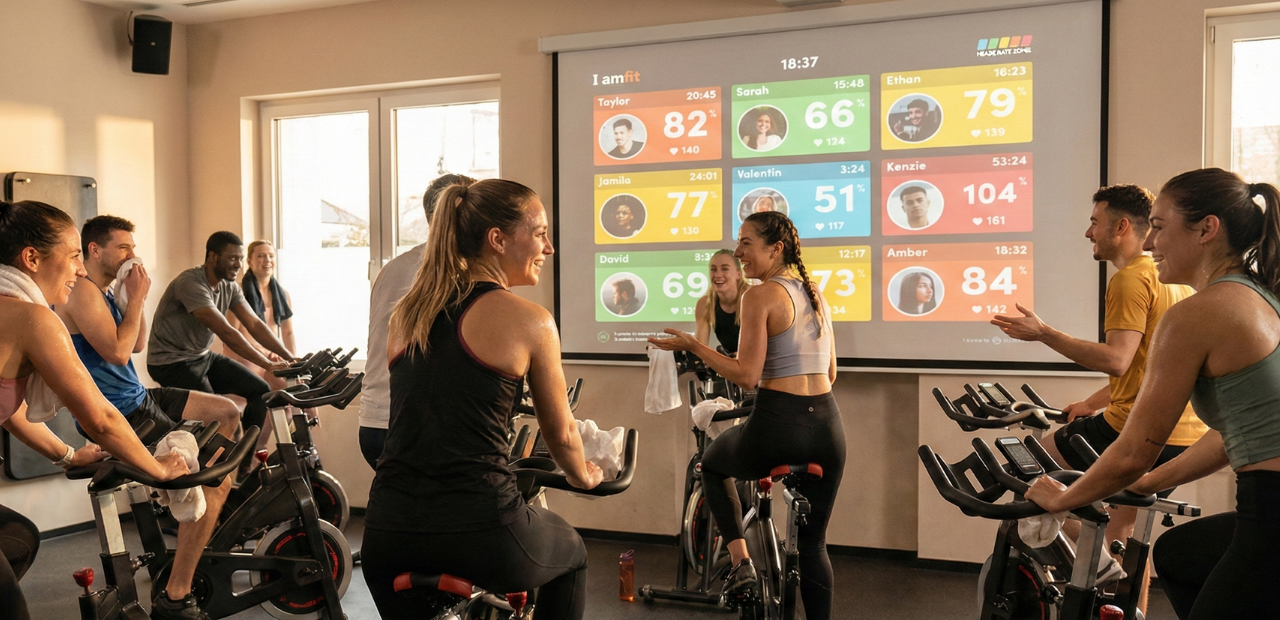You’ve probably noticed it by now your members are glued to their smartwatches, checking their heart rate between sets, tracking calories burned, or flexing their latest PR on their fitness app.
Wearable fitness tech isn’t just a trend—it’s the future of how people train, measure progress, and stay accountable.
And as a fitness studio owner, you’ve got two choices: embrace it and use it to elevate your business, or risk falling behind while competitors leverage data-driven workouts to attract and retain clients.
But not all wearable fitness programs are created equal.
Some integrate seamlessly into your studio’s ecosystem, enhancing the member experience and boosting engagement, while others can be more trouble than they’re worth.
That’s why in this guide, we’ll break down the best fitness tracker for studios—what they offer, how they fit into your business, and which one might be the game-changer you need.
The Benefits of Wearable Fitness for Your Studio

Let’s break down exactly why wearable fitness tech belongs in your studio.
Personalized Training = Better Client Results
Gone are the days of one-size-fits-all training. Wearable technology allows you to track real-time data such as:
✔ Heart rate zones – See whether a client is in the fat-burning, cardio, or peak performance zone.
✔ Calorie burn – Give clients real-time feedback on their energy expenditure.
✔ HRV (Heart Rate Variability) & recovery scores – Help clients optimize their training based on their body’s readiness.
✔ Step count & activity levels – Encourage movement outside of class.
When you can track this kind of data, you can customize workouts in ways that weren’t possible before.
- A client struggling with recovery? Adjust intensity.
- Someone barely breaking a sweat? Push them harder.
- A new member unsure if they’re progressing? Show them the numbers.
Why does this matter?
Because when clients see progress in black and white, it reinforces their effort. They’re more likely to stay consistent and committed. And you know what that means?
More progress = more motivation = higher retention.
Stronger Client Retention & Engagement
One of the biggest challenges in the fitness industry is keeping members engaged long-term.
Wearable fitness tech helps by gamifying the experience. When clients can track their progress in real-time and compare it with others, they feel a sense of accountability and motivation to keep showing up.
Think about it:
✅ Live leaderboards tracking effort levels in real-time (great for group training).
✅ Monthly challenges (e.g., burn 10,000 calories in a month, complete 20 classes, etc.).
✅ Personalized performance reports to keep clients motivated.
This taps into a few psychological triggers:
- The power of competition – Some clients love seeing their name on top of a leaderboard.
- The drive for progress – Tangible results make people feel accomplished.
- The habit loop – The more a client interacts with their data, the more engaged they are.
The result is fewer membership cancellations, higher attendance, and better client satisfaction.
Data-Driven Decisions for Your Business
Imagine knowing exactly which classes generate the highest effort, which clients are disengaging, and who’s at risk of canceling—all backed by real-time data.
With wearables, you can:
📊 Track performance trends – See which workouts drive the most results.
📉 Spot inactive members – Identify clients who haven’t engaged in weeks and re-engage them before they cancel.
🔄 Adjust programming – Optimize class intensity based on real-time feedback.
Example:
Let’s say your HIIT classes consistently show higher calorie burn and heart rate engagement compared to other sessions. What does that tell you?
These classes are working. Maybe you need to schedule more of them or create variations to keep interest high.
On the flip side, if your strength classes are seeing lower engagement, maybe it’s time to modify the structure or introduce a new format.
Instead of guessing what’s working, you’ll have hard data to back it up.
New Revenue Streams (Yes, More $$$)
Wearable fitness programs don’t just improve client experience—they open up multiple revenue opportunities.
Here’s how you can monetize wearable fitness:
- Premium coaching services – Offer VIP memberships where clients get weekly performance breakdowns based on their wearable data.
- Custom training programs – Create individualized fitness plans based on recovery scores, HRV, and calorie burn data.
- Exclusive studio challenges – Run paid competitions (e.g., $20 entry fee to win a prize for the highest total calorie burn).
- Selling branded wearables – Partner with brands to sell studio-branded wearables that sync with your tracking system.
Think about it: If you charge an extra $50/month for personalized data-driven coaching and just 20 clients sign up, that’s an extra $1,000 per month in revenue.
And that’s just one of the ways you can use wearables to increase your bottom line.
A Competitive Edge in a Crowded Market
Competition is fierce. There are boutique gyms, big-box chains, at-home fitness apps, and digital coaching platforms all fighting for the same clients.
So why should someone choose your studio?
Because you offer something better.
Wearables enhance the member experience in ways most studios can’t:
✔ Data-driven progress tracking – Not just “how you feel,” but real performance metrics.
✔ Smart programming – Adjust workouts based on recovery and real-time stats.
✔ Tech-driven community – Leaderboards, challenges, and performance-based rewards.
Here’s the thing:
Most fitness studios are still relying on old-school methods—manual tracking, subjective progress reports, and basic workouts.
By incorporating wearable fitness, you show that you’re:
- Forward-thinking – You’re not just another gym. You’re using tech to innovate.
- Results-focused – Clients don’t just “work out”—they optimize their fitness.
- Community-driven – Engagement goes beyond classes—it’s an interactive experience.
Bottom line is studios that adapt thrive. Studios that don’t… fade out.
How to Choose the Right Wearable for Your Business/Studio?

So, how do you pick the right wearable for your fitness business?
Let’s break it down.
Start with Your Studio’s Goals
Before you even think about buying wearables, get clear on why you want them in the first place.
Ask yourself:
- Do I want to improve client accountability? (Think heart rate monitoring, progress tracking, and real-time workout data.)
- Am I looking to gamify workouts? (Live leaderboards, team challenges, and reward-based tracking.)
- Do I want to enhance client retention? (Wearables that integrate with apps, send reminders, and track consistency.)
- Will these help me offer a premium experience? (Advanced metrics like HRV, recovery scores, and stress tracking.)
Your goal determines your wearable choice.
For example:
- If you run a HIIT or bootcamp studio, look for heart rate monitors that sync to a screen for live feedback.
- If you focus on strength training, get wearables that track power output, strain, and progressive overload.
- If your studio is wellness-based, prioritize recovery-focused devices that track HRV, sleep, and stress levels.
Pick a wearable that aligns with what your studio actually needs—not just what’s popular.
Check Compatibility with Your Existing Setup
Not all wearables play nice with your fitness studio software.
And if a device doesn’t integrate smoothly, it’s going to cause more headaches than gains.
Before committing, check:
✅ Does it sync with your fitness studio management software?
✅ Can it integrate with your workout programs (so trainers can track client progress effortlessly)?
✅ Does it allow real-time data sharing (for live workout tracking or post-session reports)?
Example:
If you’re using Vituagym, you might want wearables that automatically sync workout data into client profiles.
If you run group fitness classes, a system like Myzone can display real-time heart rate zones on a big screen, turning every session into a mini competition.
The smoother the integration, the less friction for both trainers and clients.
Prioritize User-Friendliness
A wearable is only as good as how easy it is to use.
Ask yourself:
- Can my clients set it up in under 5 minutes?
- Will my trainers be able to access and analyze the data effortlessly?
- Does it require constant troubleshooting?
If a client has to read a manual just to sync their heart rate, you’ve already lost them.
Pick a wearable with:
✅ One-tap syncing (No complicated setup steps)
✅ An intuitive mobile app (So clients can view data easily)
✅ Minimal charging requirements (If the battery dies mid-workout, they won’t use it)
If a device isn’t plug-and-play simple, it’ll frustrate clients and trainer, leading to low adoption rates.
Look at Data Accuracy & Metrics
Not all wearables are created equal.
Most fitness trackers provide general insights, but some offer significantly more precise data, while others… well, let’s just say they guess more than they measure.
Depending on your studio’s focus, you need reliable tracking for:
- Heart rate monitoring (Essential for HIIT, cardio, and endurance training)
- Calorie expenditure (For weight loss-focused clients)
- VO2 max & oxygen levels (Great for high-performance athletes)
- Sleep & HRV (heart rate variability) (Ideal for recovery-based programs)
- Strength & power output tracking (For weightlifting and CrossFit-style training)
Example:
- If your clients rely on heart rate data, go for chest strap monitors, they’re considered the most accurate fitness tracker option compared to wrist-based sensors.
- If you want detailed strength metrics, look for a wearable device, which offer strain tracking and fatigue scores.
The more accurate the data, the better the results—for both clients and your coaching team.
Consider the Cost (And ROI)
Wearables aren’t cheap.
If you’re rolling them out for your entire studio, the costs add up fast.
So, before you drop thousands, ask yourself:
- Can I monetize this program? (e.g., premium membership tiers with wearable tracking)
- Will it improve retention? (Clients who track progress = clients who stay longer)
- Does it help me offer a higher-value service? (More data = more personalized coaching)
Example:
Some gyms sell wearables as part of a membership upsell. Others rent them out for a fee.
If a wearable increases client retention by even 2-3 months, it could easily pay for itself.
Durability & Battery Life
Your clients aren’t wearing these in an office, they’re sweating, sprinting, lifting, and (let’s be honest) probably dropping them.
Go for wearables that are:
✅ Sweat & water-resistant (So they survive intense workouts)
✅ Durable (Because gym floors are not forgiving)
✅ Long battery life (So clients actually use them)
If a device dies mid-session, it becomes dead weight in your studio.
Community & Engagement Features
One of the biggest perks of wearables? Building a fitness community inside your studio.
Look for features like:
✅ Live leaderboards (For real-time workout tracking & friendly competition)
✅ Gamification & challenges (Think step counts, heart rate zones, and consistency streaks)
✅ Trainer feedback integration (So coaches can personalize programs based on wearable data)
The more interactive and engaging the wearable experience, the more motivated clients stay.
And more motivation = better retention.
How To Implement Wearables in Your Fitness Programs
Let’s break it down step by step.
Start With a Clear Goal

Before you invest in wearable tech for your studio, take a step back and figure out the why.
- What’s the primary reason for integrating wearables?
- Are you looking to increase accountability, boost class engagement, or offer personalized progress tracking?
- How will wearables enhance your existing training programs?
A clear purpose will help you choose the right technology and ensure a smooth implementation.
For example, if your goal is to increase motivation in group classes, you’ll want a system that allows members to see real-time heart rate zones and calorie burn.
If your focus is on personalized training, then wearables that track recovery, HRV (heart rate variability), and individual effort levels would be ideal.
Knowing your goals upfront will save you time, money, and frustration later on.
Keep It Simple (At First)

The worst thing you can do is overwhelm your members with too much data too soon.
Fitness wearables can track everything from heart rate to sleep quality to oxygen saturation levels but do your members need all that information right away?
Probably not.
Instead, start with these core metrics:
✅ Heart Rate Tracking – Helps members stay in the right intensity zones during workouts.
✅ Calorie & Step Counting – Simple but effective for accountability and motivation.
✅ Effort-Based Metrics – Helps gauge workout intensity without relying solely on reps and sets.
Once your members (and staff) are comfortable with the basics, you can introduce more advanced features over time.
This phased approach ensures adoption rather than confusion.
Make Wearables Part of the Experience

One of the biggest mistakes fitness studios make is treating wearables as an add-on instead of an integrated part of their programs.
If members feel like it’s optional, most won’t bother.
To avoid this, wearables should be woven directly into your classes and training programs.
Here’s how:
- Real-Time Display Screens – Show members their heart rate zones, calorie burn, or effort levels during workouts. This not only keeps them engaged but also helps them self-regulate intensity.
- Data-Driven Training Adjustments – If a member’s heart rate is consistently low during HIIT sessions, they might not be pushing hard enough. If it’s too high in a strength workout, they might need longer rest periods. Wearable data lets your personal trainers make instant adjustments.
- Challenges & Leaderboards – Create monthly competitions based on calorie burn, total steps, or time spent in optimal heart rate zones. Gamification keeps members motivated and engaged.
When wearables become an essential part of the workout experience, adoption rates skyrocket.
Teach Your Staff First

Your staff should be experts on wearables before rolling them out to members.
If your trainers don’t fully understand how to use the tech, they won’t be able to guide members effectively.
This leads to confusion, frustration, and low participation.
Make sure your staff can:
- Explain wearable metrics in simple terms – Members don’t need to hear about VO2 max and HRV science; they need to know what their heart rate zones mean for their results.
- Use wearable data to modify workouts – A trainer should be able to adjust intensity, rest periods, or exercise selection based on real-time data.
- Troubleshoot common issues – If a member’s device isn’t syncing, disconnects mid-workout, or gives inaccurate readings, your staff should know how to fix it on the spot.
Hold training sessions for your team before launching wearables to members. The more confident they are, the smoother the rollout will be.
Gamify The Experience

People love competition. They also love seeing their progress.
Wearables let you tap into both.
Here are a few ways to make fitness more engaging using wearable data:
🏆 Point-Based Challenges – Award points for hitting daily step goals, maintaining a target heart rate, or completing a set number of workouts per month.
🎯 Level-Up Systems – Introduce achievement levels (Beginner, Intermediate, Advanced) based on cumulative effort, encouraging members to progress over time.
💬 Community Leaderboards – Display top performers on a studio leaderboard (either in-studio or via an app) to foster a friendly competitive spirit.
Making fitness fun keeps members coming back.
Make It Personal

Generic workout plans don’t work for everyone.
The beauty of wearables is that they allow you to personalize each member’s experience.
Use wearable data to:
✔️ Send personalized progress updates – Automated reports showing workout intensity, calories burned, and overall progress keep members motivated.
✔️ Recommend workout modifications – If a member’s wearable data shows signs of fatigue, adjust their program accordingly.
✔️ Guide recovery strategies – If a member’s HRV score is low, they may need extra rest or lighter workouts to avoid overtraining.
When members feel like their fitness journey is tailored to them, they stay engaged.
Keep The Tech User-Friendly

Wearable technology should make workouts easier, not more complicated.
That means:
- Simple Setup – The onboarding process should take no more than a few minutes.
- Easy-to-understand Data – Members shouldn’t need a science degree to interpret their stats. Use visuals like color-coded zones and simple score summaries.
- Seamless Syncing – Make sure the wearables work flawlessly with your studio’s apps, displays, or tracking systems.
A smooth user experience is critical to long-term success.
Use Data to Improve Your Studio

Wearables don’t just help members—they help you optimize your business.
By tracking aggregate data across all members, you can:
- Identify Popular Class Formats – See which workouts lead to the highest engagement and energy expenditure.
- Predict Member Drop-Off – If someone’s wearable data shows declining participation, it might be time for a personal check-in.
- Optimize Scheduling – If members tend to have higher energy levels at certain times of the day, adjust class times accordingly.
Wearable data eliminates guesswork and allows you to run a smarter, more effective studio.
Make Use Of Heart Rate Zone-Based Training with Virtuagym FitZone™ 🧡

Heart rate zone training isn’t new, but having real-time feedback during workouts changes the game.
Instead of guessing if you’re pushing hard enough or pacing correctly, wearables like the NEO Health BEAT offer continuous heart rate monitoring, tracking heart rate zones throughout the session.
Whether it’s fat loss (green zone), endurance building (yellow zone), or peak performance (red zone), this kind of tracking helps keep things structured. No overdoing it.
No slacking off. Just data-driven training that removes the guesswork.
How FitZone™ Changes Group Training
Group classes thrive on energy, accountability, and structure. FitZone™ adds another layer by displaying live heart rate data on a screen so participants can see exactly where they stand.
🔸 Color-coded zones show intensity levels in real time.
🔸 Instant feedback helps participants adjust effort on the spot.
🔸 Trainers get better insights into how hard everyone is actually working.
Some might push harder when they see they’re below target, while others might realize they need to pull back. Either way, everyone stays in the right zone for their goals without relying on “how it feels.”
Seamless Wearable Integration
The system works with NEO Health, Garmin, Polar, and Myzone, syncing directly with the Virtuagym app.
Trainers can check performance data immediately, making it easier to monitor progress over time.
For those who like tracking their workouts outside of class, the data is already stored no extra effort is needed.
Using Heart Rate Data to Improve Retention
Consistency in training matters more than what happens in one or two sessions. When people can see their progress in real numbers, it adds a layer of accountability.
Instead of relying on how they “feel” after a workout, they can look at objective data that shows if they’re improving.
Over time, this keeps motivation from fading and helps build long-term habits.
For trainers, having access to heart rate trends also allows for better coaching decisions.
If someone constantly stays in the wrong zone, adjustments can be made before frustration sets in.
A Shift Toward Smarter Training
Heart rate zone-based training isn’t just about working harder, it’s about working smarter.
When done right, it helps prevent burnout, improves recovery, and makes sure workouts actually align with goals.
Having real-time tracking in a group setting just makes it easier to stay on track without second-guessing effort levels.
Whether the goal is performance, endurance, or fat loss, structured training based on real data gives a clearer path forward.
Connect To Your Fitness Studio Software

Managing a fitness studio comes with a lot of moving parts, from tracking workouts to handling memberships and keeping members engaged.
When systems don’t talk to each other, things can get messy fast.
That’s where our partner integrations come in.
Virtuagym connects with leading fitness brands like EGYM, Life Fitness, and Matrix, making it easier to automate workout tracking, sync RFID access, and manage member profiles all in one place.
Instead of manually updating workout logs or handling check-ins separately, members can scan a QR code or RFID tag to connect directly with partner equipment.
Their progress is tracked automatically, reducing the need for extra input.
For trainers and operators, this means less admin work and more time to focus on coaching and client experience.
Wearable-Compatible Fitness Studio Equipment

Wearables and smart gym equipment are shifting how members track their workouts—and how studios operate.
Virtuagym’s integration with Matrix Fitness is an example of this, bringing automated strength and cardio tracking into the studio setting.
Here’s how it works:
- RFID-enabled machines automatically log reps, sets, and weights.
- Data syncs directly to the member’s Virtuagym profile.
- Trainers can adjust workout plans based on real-time progress.
With 22 advanced Matrix strength training consoles now integrated, members get a more personalized and data-driven training experience.
They no longer have to manually record workouts, and trainers have instant access to real-time performance insights.
For studio owners, this kind of connectivity helps improve retention and engagement—members can see their progress, which makes them more likely to stay consistent.
Simplifying Operations with Smarter Technology
When gym equipment, wearables, and management software are all connected, running a fitness studio becomes a lot more efficient.
Trainers don’t have to chase down workout logs, members get a more seamless experience, and operations run with fewer manual processes.
By integrating Virtuagym’s management platform with RFID-compatible fitness equipment, studios can create a more streamlined, tech-enabled environment that reduces administrative tasks while improving the way members train and track their progress
Best Wearable Fitness Trackers and Their Integration with Fitness Studio Programs
Whether you run high-energy group classes or focus on personal training, here’s a breakdown of the best wearables and how they can seamlessly integrate into your studio’s programs.

Neo Health
The NEO Health GO is a solid all-around fitness tracker that monitors heart rate, steps, and even incoming messages. It syncs effortlessly with fitness apps, giving both you and your clients a clear view of progress.
But whats even advanced is the NEO Health BEAT.
This device comes with FitZone functionality, which allows you to project live heart rate zones on a screen during group sessions.
It features color-coded intensity zones showing whether someone is in the fat-burning stage or pushing peak performance.
This isn’t just another fitness tracker—it’s an engagement tool. When clients see their effort in real-time, they stay motivated, push harder, and feel a stronger connection to their workouts.
Perfect for keeping classes competitive and personal training goal-oriented.
Fitbit Charge 6
Fitbit Charge 6 is a basic fitness tracker.
No fancy extras, just solid tracking. It logs steps, heart rate, calories burned, and sleep patterns.
The SpO2 sensor adds another layer of health monitoring, and Google app integration makes navigation easier.
Apple Watch Series 10
Apple Watch isn’t just a traditional fitness tracker—it’s a full-on smartwatch designed with iPhone users in mind, offering seamless integration with iOS features like Apple Health and Siri.
It tracks heart rate, VO2 max, sleep, and workout performance while letting you answer calls and reply to texts.
The always-on display makes it easy to glance at data, and it syncs effortlessly with iPhones.
Garmin Vívoactive 5
Garmin isn’t just for runners, it’s for anyone who likes detailed fitness tracking with a focus on health features like sleep analysis, stress monitoring, and HRV tracking.
Battery life is better than most smartwatches, which is a plus if you don’t want to charge it every night.
WHOOP
WHOOP is a different beast. No screen, no notifications just 24/7 biometric tracking.
It analyzes strain, recovery, and sleep to optimize training.
WHOOP doesn’t count steps or give instant readouts like other wearables, instead focusing on more advanced health-tracking features like recovery optimization and strain analysis.
Amazfit Active 2
Amazfit Active 2 offers a large AMOLED display, GPS tracking, heart rate monitoring, and SpO2 tracking, making it a solid choice for basic fitness tracking at a lower price point.
It supports over 160 workout modes and has a 5-day battery life.
Sleep tracking can be hit-or-miss, but for basic fitness monitoring, it gets the job done.
Oura Ring
Oura Ring is a sleek and subtle option for those who want detailed recovery data.
It’s a small ring that tracks sleep quality, heart rate, body temperature, and activity levels.
Unlike most wearables, Oura is all about rest and recovery, helping you understand how well your body is recovering from workouts.
It’s perfect for those who want to track how their lifestyle—especially sleep—affects their fitness.
Myzone
MyZone is a heart rate monitor with a twist. It’s designed primarily for group fitness classes and trainers to monitor participants in real-time.
MyZone displays your heart rate, calories burned, and effort level on a screen during workouts, encouraging a competitive environment.
It uses different heart rate zones to show your intensity, and you can compete with others or track your own performance.
Polar
Polar has been in the fitness tracking game for a while, and their wearables are well-regarded for their accuracy.
The Polar Vantage V2 and Grit X offer in-depth features like GPS tracking, heart rate monitoring, and recovery analysis.
They’re especially popular with endurance athletes because of their detailed training load and performance metrics.
Common Challenges With Wearables and How to Overcome Them
Let’s walk through the biggest challenges you might face and, more importantly, how to overcome them.
Privacy Concerns
Members love tracking progress, but they’re also wondering, Who’s seeing my data?
Wearables collect everything from heart rate to calorie burn, and people don’t want that info floating around.
Be upfront about how data is stored, who has access, and what’s not being shared. Choose wearables that prioritize data security and comply with privacy laws like GDPR.
Bonus points if you show clients exactly how their data benefits their progress. Trust = retention.
Tech Integration Issues
Your current booking system, workout tracking software, and new wearable tech might not play nice together. If the data doesn’t sync, it’s a nightmare for both your staff and clients.
Pick wearables with open APIs or those that already integrate with popular gym management software. Before committing, test it out. Many providers offer trials—use them. You don’t want to be knee-deep in a system that requires a PhD to operate.
Engagement Issues
You introduce wearables with a bang, but after a few weeks… crickets. Members stop using them, and now you’re wondering if it was all a waste.
Make it fun. Gamify the experience.
Create challenges, set leaderboards, and reward milestones. People love competition, and a little incentive (discounts, shoutouts, exclusive perks) goes a long way.
Also, show members real progress using their data. Seeing results = motivation = retention.
Financial Concerns
Quality wearables aren’t cheap, and let’s be real—you’re running a business. The upfront cost might feel like a risk.
Start small. Test the waters with a pilot program—maybe a handful of devices for your top members or trainers. If engagement is solid, expand.
Also, look into leasing programs or partnerships with wearable companies. Some brands offer discounts for bulk purchases.
Keeping Up with Innovation
You finally integrate a system… and six months later, there’s a new “must-have” device that makes your setup feel outdated.
Stay plugged into industry trends. Follow wearable tech brands, attend fitness tech expos, and keep an eye on what top-tier studios are doing.
Most importantly, choose a system that offers regular software updates—this way, your tech evolves without needing a complete overhaul.
Future Trends in Wearables and Fitness Studio Programs
Let’s dive into the biggest trends shaping the future of wearables in fitness studios.
Advanced Biometric Tracking: The Next Level of Personalization
You’ve probably seen wearables track heart rate, steps, and sleep—but that’s just scratching the surface.
The next generation of fitness wearables is stepping into advanced health tracking with blood oxygen levels, stress monitoring, hydration tracking, and even metabolic rate analysis.
Imagine being able to tell your clients:
👉 “Hey Sarah, your recovery score is low today—let’s dial back intensity and focus on mobility work.”
👉 “Mark, your stress levels are off the charts. Let’s add some breathwork and see how it impacts your performance over time.”
When you can tailor workouts based on REAL-TIME data, you’re not just running a fitness studio anymore.
You’re offering a high-tech, concierge-level experience.
Wearables + Studio Equipment = A Connected Gym Experience
Imagine this: Your client walks in, their smartwatch syncs automatically with the treadmill, and boom—their entire workout plan is loaded onto the screen.
This integration between wearables and gym equipment is becoming a reality.
Brands like Myzone, Whoop, and Apple are already building ecosystems where wearables seamlessly sync with gym machines, tracking performance and adjusting workouts in real time.
Why this matters for your studio:
- More engagement: Clients get instant feedback on their progress.
- Better retention: When members feel their workouts are fully customized, they stick around.
- Less guesswork for trainers: Data-driven coaching = better results, faster.
Studios that adopt connected fitness tech will have an edge. Will yours be one of them?
AI-Powered Coaching: Smarter, Not Harder
AI is coming for the fitness industry and not in a “robots taking over” way.
Wearables are starting to use artificial intelligence to analyze client data and offer personalized coaching advice.
Think real-time workout adjustments, meal suggestions, and recovery tips—all powered by AI.
For example, AI can look at:
- How well your client is recovering from their last session
- Whether they’re sticking to their step or calorie goals
- If they should go harder or take a deload week
What this means for fitness studios:
- Trainers get AI-backed insights to personalize programs.
- Clients feel like they have a 24/7 coach in their pocket.
- Your studio stands out as a cutting-edge, high-tech training facility.
Read more about the latest AI trends for fitness studios.
Virtual Reality (VR) and Augmented Reality (AR) Experiences
Fitness is no longer limited to lifting weights and running on a treadmill it’s evolving into an interactive, fully immersive experience.
Wearable technology is now integrating VR (Virtual Reality) and AR (Augmented Reality), allowing fitness studios to create engaging and personalized workouts that go beyond the physical world.
Imagine this:
A client puts on a VR headset and suddenly, they’re in a high-intensity boxing match against a virtual opponent, dodging punches and throwing jabs while getting an insane cardio workout.
Cyclists can ride through digitally enhanced landscapes, feeling changes in resistance as they ‘climb’ hills and race against others in a fully immersive environment.
Clients who struggle with motivation can follow AR-generated workout instructions, seeing real-time form corrections and feedback while training.
This technology bridges the gap between fitness and entertainment, making workouts more engaging and boosting client retention. For studios, incorporating VR and AR creates a high-tech, competitive edge that attracts members looking for something beyond a traditional gym experience.
If you want to future-proof your studio, it’s time to think beyond reality.
Data-Driven Training Programs
Gone are the days when fitness programs were built on guesswork and generic workout plans.
With wearable technology tracking real-time performance, studios now have access to a wealth of data that can be used to optimize training and enhance client results.
Wearables now track key performance indicators like:
- Heart rate variability – A crucial metric for tracking recovery, stress levels, and overall fitness readiness. If a client’s HRV is low, their session can be adjusted for recovery rather than intensity.
- Sleep patterns – Poor sleep leads to lower energy levels and suboptimal workouts. By tracking sleep data, trainers can help clients adjust routines for better performance.
- Caloric expenditure vs. effort levels – Instead of relying on estimates, real-time tracking shows how much energy is actually being used during workouts, helping to fine-tune fat loss or muscle-building goals.
By using real-time feedback, studios can personalize every client’s experience, ensuring their programs align with their body’s needs, recovery levels, and goals.
This means better retention, fewer injuries, and a reputation as a cutting-edge fitness facility.
Wearables & The Shift to Longevity & Preventive Health
The fitness industry is shifting. It’s no longer just about how much weight you can lift or how fast you can run it’s about living longer, moving better, and preventing health issues before they arise.
Wearable technology is at the forefront of this shift.
With real-time tracking of key health metrics, wearables are giving users deeper insights into how their body is functioning beyond just fitness performance.
- Stress & recovery tracking – High-stress levels can impact physical performance, recovery, and even weight loss. Wearables that monitor stress help guide recovery and prevent burnout.
- Blood oxygen & heart rate variability monitoring – These indicators can signal overtraining, early signs of illness, or cardiovascular health concerns, helping clients adjust their routines before problems arise.
- Metabolic health insights – Understanding how the body responds to food, movement, and rest allows for better nutrition and workout planning, reducing the risk of metabolic conditions.
For fitness studios, this means a new opportunity to position themselves not just as a place to work out, but as a center for health optimization.
The more data-driven, preventive, and longevity-focused your approach is, the more valuable you become to clients looking for long-term wellness.
More Focus On Mental Well-being
For years, fitness has focused solely on physical performance, but the reality is that mental health is just as crucial to overall well-being.
Wearables are now bridging that gap by tracking, supporting, and enhancing mental well-being alongside physical fitness.
- Stress tracking & mindfulness features – Clients can monitor their stress levels in real-time, allowing them to adjust workouts, prioritize recovery, or integrate stress-reducing practices like meditation and breathwork.
- Sleep optimization tools – Poor sleep affects everything from energy levels to fat loss to muscle recovery. Wearables that track sleep patterns help clients understand how their rest impacts their fitness and overall health.
- Real-time biofeedback – Wearables can detect physical signs of anxiety, tension, or overtraining, helping clients and trainers adjust workouts accordingly.
A holistic approach to fitness means acknowledging that physical progress is only part of the equation.
The studios that embrace mental well-being as part of their training philosophy will stand out as leaders in a new era of fitness.
Conclusion
Wearable technology is redefining how fitness studios operate, offering smarter training, deeper client engagement, and a competitive edge in an evolving industry.
It’s no longer just about workouts—it’s about real-time feedback, personalized coaching, and creating an experience that keeps members coming back.
Adopting wearables isn’t just an upgrade; it’s a shift toward a more data-driven, results-focused approach.
Studios that embrace this innovation will strengthen client loyalty, improve retention, and position themselves at the forefront of the fitness industry.
The future is already here now it’s time to make it part of your studio.




